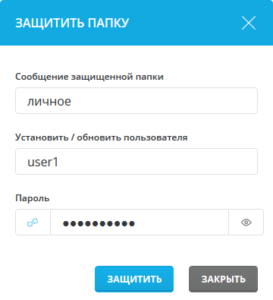Additional features
This document contains information about error pages (404, etc.), password protection of the directory, server information, cron jobs, mime types, apache handlers, site redirects, domain pointers, and placement of additional domains.
404 error pages

 To access the error pages, log in to the control panel, and then click the “Advanced Features” icon, and then the “Error Pages” link
To access the error pages, log in to the control panel, and then click the “Advanced Features” icon, and then the “Error Pages” link
Error pages allow you to control what visitors see when they encounter these types of errors:
401 Unauthorized (visitor has no rights to view file/directory)
403 Forbidden (file/directory cannot be accessed)
404 File or directory not found
500 There was an error on the server
The custom error pages have default text, which you can view by clicking the “View” button, or change by clicking “Edit”.
Changing the error pages
There are two ways to change the error pages:
Method 1:
From the “Error Pages” menu, click the “Edit” button on the error page you want to edit (see Figure above). A text box will appear and you can paste your HTML code into the text box.
Method 2:
Create the files yourself in any HTML editor and upload them to your public_html directory. The files must have a .shtml extension. You can find more information about uploading and editing files here.
Password protection for the directory

 To access the “Protected folders” menu, log in to the Control Panel, then click the “Advanced Features” icon and then the “Protected folders” link.
To access the “Protected folders” menu, log in to the Control Panel, then click the “Advanced Features” icon and then the “Protected folders” link.
From there you will see all the password-protected directories. You can click the “Find folders for password protection” link above the directory table to access protected directories in the File Manager, or you can click the directory name to edit the desired password-protected directory.
If you want to protect new directories, click the “Find folders for password protection” link (see the image above). Then click the “+” button to the right of the desired folder and click the “Protect” link.
Add a protected directory
Fill in the Protected folder message (description of the password-protected directory), the user name for the directory and the password for the directory. Click Save.
Now type the full directory address into your browser and see what happens.
Changing password-protected directories
Click on the directory path to edit the directory. From here you can update the directory name, add new or delete old directory users.
You can also remove protection from the directory by simply clicking the “Remove Protection” button in the upper right corner of the window.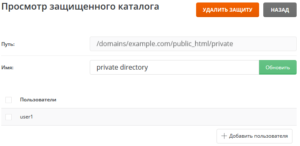
Server information

 To access the Server Info menu, log in to the Control Panel and click the System and Files icon, then the Server Info link.
To access the Server Info menu, log in to the Control Panel and click the System and Files icon, then the Server Info link.
The server information function allows you to determine the server’s memory usage, uptime, CPU information and the status of all services.
Cron tasks

 To access the Cronjobs menu, log in to the Control Panel and click the Advanced Features icon and then the Cronjobs link.
To access the Cronjobs menu, log in to the Control Panel and click the Advanced Features icon and then the Cronjobs link.
Cron jobs are system commands that can be scheduled. For example, if you want the value “hi” to be added to a text file every Monday morning, you can do this through the cron job menu. The values of minutes, hours, days, months and days of the week (Monday-Sunday; digits 0 or 7 represent Sunday) can be set. Any value can be ignored by putting an asterisk (*) in the text box.
 In the above example, we set the echo command to put the word “hi” in the hi_per_hour.txt file every day at midnight.
In the above example, we set the echo command to put the word “hi” in the hi_per_hour.txt file every day at midnight.
You can also specify exact times, using commas to separate them (e.g., 1,2,3 – minutes 1, 2 and 3).
You can specify intervals using the dash (for example, 5 to 7 minutes is 5 to 7).
You can specify intervals using an asterisk and a slash. (e.g.: */2 every 2 minutes.)
You can combine them to create a more accurate schedule. (e.g: 1,5,11-15,30-59/2 (minutes 1, 5, 11-15 and every 2 minutes between 30 and 59).
Don’t forget to click the “Create” button below when you are finished entering your information.
If you are trying to run a php script, don’t forget to run the php binary and pass the php script to it. For example:
/usr/local/bin/php /home/user/domains/domain.com/public_html/file.php
Mime Types

 To access the Mime Types menu, log in to the Control Panel and then click the Advanced Features icon and then the Mime Types link.
To access the Mime Types menu, log in to the Control Panel and then click the Advanced Features icon and then the Mime Types link.
MIME types allow you to set how browsers open web files. To add a mime-type, enter a mime-type name followed by an extension without a dot. MIME types (and Apache handlers – described below) should only be used by experienced users.
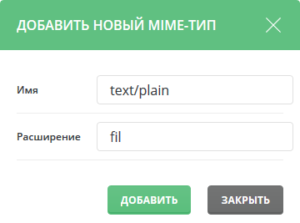 In the above example, web browsers open *.fil files as text documents.
In the above example, web browsers open *.fil files as text documents.
To add a MIME type, click the “Add MIME type” button.
At the bottom of the MIME types menu is a link to a list of all MIME types currently installed on the system.
Apache Handlers

 To access the Apache Handlers menu, log in to the Control Panel and click the Advanced Features icon, then the Apache Handlers link.
To access the Apache Handlers menu, log in to the Control Panel and click the Advanced Features icon, then the Apache Handlers link.
Handlers tell Apache (web server software) what to do with certain file types. For example, the .cgi and .pl extensions are handled by Perl. You can make Apache handle .scr files with Perl, using the appropriate handlers.
To add a handler, simply click the “Create Handler” button, then enter the name and extension of the handler (without the dot) and click “Create”.
In the above example, Apache will treat all .ima files as IMAP types, even if the default extension for image maps is .map.
At the bottom of the apache handlers menu is a link to a list of all the handlers currently installed on the system.
Redirecting the site

 To access the Site Redirect menu, log in to the Control Panel and click the Accounts icon and then the Site Redirect link.
To access the Site Redirect menu, log in to the Control Panel and click the Accounts icon and then the Site Redirect link.
Website redirects allow you to redirect visitors somewhere to your site or to another site altogether.
 In the above example, visitors to http://example.com/tuthost will be sent to http://www.tuthost.com.
In the above example, visitors to http://example.com/tuthost will be sent to http://www.tuthost.com.
Enter a slash (/) in the Local URL Path field to redirect all visitors to your domain (http://www.example.com) to the specified destination URL.
Domain indexes
Note. Domain pointers are disabled by default for users in DirectAdmin. If you don’t see the “Domain Pointers” link in “Accounts”, please contact your administrator.

 To access the Domain Pointers menu, log in to the Control Panel and click the Accounts icon and then the Domain Pointers link.
To access the Domain Pointers menu, log in to the Control Panel and click the Accounts icon and then the Domain Pointers link.
Domain pointers allow you to redirect other domains to your main website. Be sure to change these domain entries to the same name servers as your main website (this is done through your domain registrar).
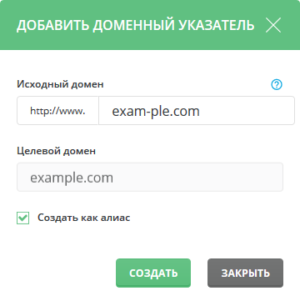 Let’s say we also have an example.com domain. In the example above, we create a pointer that leads all visitors to exam-ple.com to example.com.
Let’s say we also have an example.com domain. In the example above, we create a pointer that leads all visitors to exam-ple.com to example.com.
Check “Create as alias” if you want users to see links to example.com instead of exam-ple.com in the browser.
Don’t forget to click “New” when you have finished entering the source domain.
Note. The pointer can be activated for up to 72 hours due to a DNS update.
Hosting additional domains

 To see all of your current domains, log in to your control panel, and then click the Accounts icon and then the “Domain Setup” link.
To see all of your current domains, log in to your control panel, and then click the Accounts icon and then the “Domain Setup” link.
Here you can see all the listed domains . You can also add a new domain or rename an existing domain. To place an additional domain, click the “Add New Domain” button at the top of the page.
First, enter the domain name. Use lower case letters. You don’t have to type “http://” or “www.
Second, select the bandwidth and disk usage available for that domain. If you only need 1 gigabyte of transmission per month, enter 1,000 in the “Traffic” field. If you want to share traffic with the main domain without restrictions, check “As for the main account”. Finally, click Create.
 You can also choose what access your site will have. Choose only if you know what you are doing, otherwise just leave the default.
You can also choose what access your site will have. Choose only if you know what you are doing, otherwise just leave the default.
Be sure to change the NS-records of the new domain, so that it uses the same name servers as your primary domain (this is done through the domain registrar). New domain resolution can take up to 72 hours to activate due to DNS updates.
Logging into the control panel
 Enter the control panel. You will see a selection of domains hosted on your account. Click on the domain you want to work with.
Enter the control panel. You will see a selection of domains hosted on your account. Click on the domain you want to work with.
Uploading files to each domain
Uploading files to each domain is very easy. When you use FTP or the control panel’s built-in file manager, go to the domain directory and select the domain to which you want to upload a file.
Renaming a domain
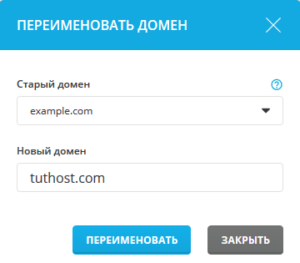 You can change the domain name from example.com to tuthost.com. Just click the “Rename Domain” button.
You can change the domain name from example.com to tuthost.com. Just click the “Rename Domain” button.
Then select the old domain from the list.
Enter the new desired domain name (without “www” or “https://”) and click “Rename”.


